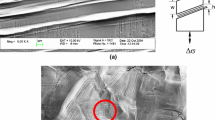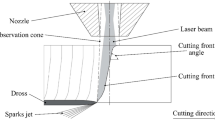Conclusions
The experimental crack-length measurement data showed that both the laser and the X-ray approaches are viable. However, based on performance margins and system implementation considerations, the laser approach is recommended. A system design of a laser-automated fatigue-crack measurement instrument is presented in Fig. 12. A vision system is proposed to meet the performance requirements on Table 3. The laser and vision system are cart mounted for maximum utility. This configuration is shown in Fig. 13. A prototype system will be built and tested on the Phase II program. At the conclusion of Phase II, Foster-Miller will be looking for a venture partner to commercialize the system.
Similar content being viewed by others
References
Bachman, V. and Nuns, D., “Fatigue Crack Closure Evaluation with the Potential Method,” Eng. Fract. Mech., 11, 61–71 (1979).
Rief, F., “Fundamental of Statistical and Thermal Physics,” McGraw-Hill, NY (1965).
Filter data sheets, Ealing Corp., Natick, MA, alternates: Micro-coatings, Westford, MA or Barr Associates, Westford, MA.
Author information
Authors and Affiliations
Rights and permissions
About this article
Cite this article
Kirchner, T.E., Nagar, A., Domash, L. et al. Crack-measurement techniques for high-temperature applications. Exp Tech 12, 26–31 (1988). https://doi.org/10.1111/j.1747-1567.1988.tb02170.x
Published:
Issue Date:
DOI: https://doi.org/10.1111/j.1747-1567.1988.tb02170.x




